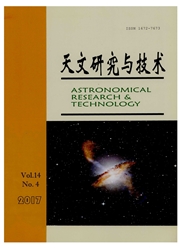

 中文摘要:
中文摘要:
研究了低红移SDSS类星体(0.025<z<0.5)的辐射效率.首先利用类星体中心黑洞的质量估计,通过薄盘吸积模型估计了每一个类星体的吸积率.其次根据光学波段的观测光度,利用经验的类星体全波段模板谱估计了每个类星体的热光度.最后由估计的吸积率和热光度得到了每个类星体的辐射效率.发现低红移SDSS类星体的辐射效率与黑洞质量强相关,并满足ε∝M.0.63.这一结果与Davis和Laor(2011)对PG类星体样本得到的结果一致.进一步讨论由于辐射效率估计中各种假设可能引入的偏差及其对ε与M.关系的可能影响.
 英文摘要:
英文摘要:
Radiation efficiencies of QSOs are believed to be determined by the angular momenta of their central Massive Black Holes (MBH). Assembly histories of MBH may have shaped their angular momenta. In this paper we estimate radiation efficiencies of selected low-redshift SDSS QSOs ( 0. 025 〈z 〈 0. 5 ). Using estimated Virial-mass values to approximate the MBH mass (M.) values, we fit predictions of the standard model of thin accretion disks to observed optical luminosities of the QSOs to individually estimate their accretion rates. The bolometric luminosity of each QSO is estimated by extrapolating its observed optical luminosities in different bandpasses using empirical panchromatic templates established through various observations. With the estimated accretion rate and bolometric luminosity we obtain the radiation efficiency of each QSO. We find a strong correlation between the radiation efficiency (ε) and the black-hole mass, ε ∝M.^0.63, which is similar to the result of Davis & Laor (2011). The estimated radiation efficiency of an individual MBH has a large error which includes errors propagated from various sources. We further discuss various possible biases involved in the estimates of the radiation efficiencies, as these biases potentially contribute to the result ε-M. relation. These include the uncertainty of approximating the MBH mass with the estimated Virial mass, the oversimplification of the accretion-disk model, the sample selection effects, and the errors of the estimated bolometric luminosities due to the limited database for templates and unknown dust/gas obscuration.
 同期刊论文项目
同期刊论文项目
 同项目期刊论文
同项目期刊论文
 SDSS QUASARS IN THE WISE PRELIMINARY DATA RELEASE AND QUASAR CANDIDATE SELECTION WITH OPTICAL/INFRAR
SDSS QUASARS IN THE WISE PRELIMINARY DATA RELEASE AND QUASAR CANDIDATE SELECTION WITH OPTICAL/INFRAR Discovery of six high-redshift quasars with the Lijiang 2.4 m telescope and the Multiple Mirror Tele
Discovery of six high-redshift quasars with the Lijiang 2.4 m telescope and the Multiple Mirror Tele The age-redshift relation for luminous red galaxies obtained from full spectrum fitting and its cosm
The age-redshift relation for luminous red galaxies obtained from full spectrum fitting and its cosm The cosmic evolution of massive black holes and galactic spheroids: global constraints at redshift z
The cosmic evolution of massive black holes and galactic spheroids: global constraints at redshift z THE LOW FREQUENCY OF DUAL ACTIVE GALACTIC NUCLEI VERSUS THE HIGH MERGER RATE OF GALAXIES: A PHENOMEN
THE LOW FREQUENCY OF DUAL ACTIVE GALACTIC NUCLEI VERSUS THE HIGH MERGER RATE OF GALAXIES: A PHENOMEN MICROLENSING OF SUB-PARSEC MASSIVE BINARY BLACK HOLES IN LENSED QSOs: LIGHT CURVES AND SIZE-WAVELENG
MICROLENSING OF SUB-PARSEC MASSIVE BINARY BLACK HOLES IN LENSED QSOs: LIGHT CURVES AND SIZE-WAVELENG 期刊信息
期刊信息
